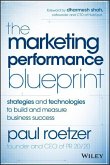Gabriela Salinas
The International Brand Valuation Manual
A Complete Overview and Analysis of Brand Valuation Techniques, Methodologies and Applications
Gabriela Salinas
The International Brand Valuation Manual
A Complete Overview and Analysis of Brand Valuation Techniques, Methodologies and Applications
- Gebundenes Buch
- Merkliste
- Auf die Merkliste
- Bewerten Bewerten
- Teilen
- Produkt teilen
- Produkterinnerung
- Produkterinnerung
The International Brand Valuation Manual is a detailed and extensive review of the main brand valuation models. The book reveals the state of the art in the field of brand valuation and coherently relates major trends in the theory and practice of brand valuation. This "one-stop" source is for valuation professionals as well as financial and marketing specialists who need to have an understanding of the principal valuation methods. Salinas also analyses the respective efficacy, advantages, disadvantages, and prospects for the future for each method. The book: - Provides a thorough overview of…mehr
Andere Kunden interessierten sich auch für
![The Marketing Performance Blueprint The Marketing Performance Blueprint]() Paul RoetzerThe Marketing Performance Blueprint29,99 €
Paul RoetzerThe Marketing Performance Blueprint29,99 €![Entry Strategies for International Markets Entry Strategies for International Markets]() Franklin R. RootEntry Strategies for International Markets55,99 €
Franklin R. RootEntry Strategies for International Markets55,99 €![Herd Herd]() Mark EarlsHerd20,99 €
Mark EarlsHerd20,99 €![Energize Growth NOW Energize Growth NOW]() Lisa NirellEnergize Growth NOW24,99 €
Lisa NirellEnergize Growth NOW24,99 €![The Business of Event Planning The Business of Event Planning]() Judy AllenThe Business of Event Planning29,99 €
Judy AllenThe Business of Event Planning29,99 €![The Social Media Management Ha The Social Media Management Ha]() Nick SmithThe Social Media Management Ha23,99 €
Nick SmithThe Social Media Management Ha23,99 €![The Irresistible Offer The Irresistible Offer]() Mark JoynerThe Irresistible Offer30,99 €
Mark JoynerThe Irresistible Offer30,99 €-
-
-
The International Brand Valuation Manual is a detailed and extensive review of the main brand valuation models. The book reveals the state of the art in the field of brand valuation and coherently relates major trends in the theory and practice of brand valuation. This "one-stop" source is for valuation professionals as well as financial and marketing specialists who need to have an understanding of the principal valuation methods. Salinas also analyses the respective efficacy, advantages, disadvantages, and prospects for the future for each method. The book: - Provides a thorough overview of all the tools available for the brand valuation practitioner. - Offers an informed view on which methodologies are most suitable for different types of applications, and explains why. - Acts as an all-in-one source of reference for specialists who advise clients on which methodology to employ, or who are considering adopting one themselves. - Features case studies and examples from Guinness, PwC, Rolls-Royce, Santander, Shell, Telefonica, Unilever, BMW, Hanson Trust, Cadbury-Schweppes, Kellogg, Coco-Cola, Mercedes, Rolex, among others. Gabriella Salinas is the Global Brand Manager at Deloitte Touche Tohmatsu, Madrid, Spain.
Hinweis: Dieser Artikel kann nur an eine deutsche Lieferadresse ausgeliefert werden.
Hinweis: Dieser Artikel kann nur an eine deutsche Lieferadresse ausgeliefert werden.
Produktdetails
- Produktdetails
- Verlag: John Wiley & Sons / Wiley
- Artikelnr. des Verlages: 14574031000
- Seitenzahl: 448
- Erscheinungstermin: 1. Oktober 2009
- Englisch
- Abmessung: 235mm x 157mm x 31mm
- Gewicht: 893g
- ISBN-13: 9780470740316
- ISBN-10: 0470740310
- Artikelnr.: 26177194
- Herstellerkennzeichnung
- Libri GmbH
- Europaallee 1
- 36244 Bad Hersfeld
- gpsr@libri.de
- Verlag: John Wiley & Sons / Wiley
- Artikelnr. des Verlages: 14574031000
- Seitenzahl: 448
- Erscheinungstermin: 1. Oktober 2009
- Englisch
- Abmessung: 235mm x 157mm x 31mm
- Gewicht: 893g
- ISBN-13: 9780470740316
- ISBN-10: 0470740310
- Artikelnr.: 26177194
- Herstellerkennzeichnung
- Libri GmbH
- Europaallee 1
- 36244 Bad Hersfeld
- gpsr@libri.de
Author Information Gabriela Salinas has a very uncommon professional profile, with deep understanding of strategic, accounting, financial and marketing issues, that has earned her a reputation as one of the world leading experts in the field of brand valuation. As Global Brand Manager of Deloitte Touche Tohmatsu, Gabriela advises internal and external clients on brand valuation and evaluation related issues. She has a broad international experience, having worked in New York, Buenos Aires, Singapore, London and Madrid for clients such as the Bank of America, Repsol YPF, Telefónica, Terra Networks, Bausch & Lomb, Johnson & Johnson, Roca, GM and Great Eastern Life and other international companies on projects involving brand evaluation, brand architecture, brand positioning and brand valuation projects. Early in her career Gabriela specialized in corporate valuation, receiving a Master in Corporate Finance and lecturing on 'Valuation of Financial Assets'. Later on, she focused on the valuation of intangible assets, developing a sound professional career in the field. As she enjoys the academic work, she led several research projects on the field and is now teaching 'Brand Valuation' at the Institute of Intangible Assets in Spain. Gabriela is now a member of the international initiative for the standardization of brand valuation methodologies, ISO/PC 231 International Committee and of the Brand and Valuation Committees of the Institute of Analysis of Intangible Assets.
List of Figures and Tables xiii
Foreword xix
Acknowledgements xxiv
Introduction xxvi
1 The Concept and Relevance of Brand 1
1.1 The concept of brand 1
1.1.1 The accounting perspective 2
1.1.1.1 The brand as an intangible asset 2
1.1.1.2 Non-recognizable intangible assets: Internally generated brands 4
1.1.1.3 Trademark, brand and branded business 5
1.1.2 The economic perspective 7
1.1.2.1 Economic vs. accounting criteria 7
1.1.3 The management perspective 8
1.1.3.1 Brand and corporate reputation 8
1.1.3.2 Brand and visual identity 11
1.1.4 Brand, intangible assets and intellectual capital - Everyday
vocabulary and conflated terms 12
1.1.4.1 Brand equity and intangible assets 12
1.1.4.2 Brand, intangible assets and intellectual capital 14
1.2 Brand value 18
1.2.1 What is brand value? 18
1.2.2 How do brands create value? 19
1.3 The growing importance of the economic value of brand 20
1.3.1 Business evidence 20
1.3.2 Social evidence 22
1.3.3 Economic evidence 22
1.3.4 Normative and institutional evidence 24
1.3.5 Academic evidence 30
1.4 Conclusions 31
2 The Origin and Evolution of Valuation Methods 33
2.1 The Origin and evolution of valuation methods 33
2.1.1 Origins: The series of acquisitions in the 1980s 33
2.1.2 The fi rst brand valuation: Rank Hovis McDougall 35
2.1.3 The accounting confl ict generated by brand capitalization 36
2.1.4 Rapid development and applications 37
2.1.5 Who values brands today? 38
2.1.6 How do corporations use this tool? 40
2.1.7 How do investment analysts use this information? 41
2.1.8 How do other players use this information? 43
2.2 Conclusions 45
3 Brand Valuation Method and Process 47
3.1 Brand valuation process 47
3.1.1 What is brand valuation? 48
3.1.2 The current debate: Why bother with brand valuation? 48
3.1.3 The purpose of brand valuation 50
3.1.3.1 Brand management 51
3.1.3.2 Accounting purposes 52
3.1.3.3 Internal or external transaction purposes 52
3.1.4 Defining the scope of valuation and the concept of brand 54
3.1.5 Choosing an appropriate methodology 54
3.2 Conclusions 56
4 General Approaches To Brand Valuation 57
4.1 Cost approach 58
4.2 Market approach 61
4.3 Income approach 63
4.3.1 Price premium 65
4.3.2 Royalty savings 70
4.3.3 Demand drivers/brand strength analysis 82
4.3.4 Comparison of gross margin with that of relevant competitors 89
4.3.5 Comparison of operating profit with that of relevant competitors 91
4.3.6 Comparison with theoretical profits of a generic product 92
4.3.7 Cash flow or income differences with a benchmark company
("subtraction approach") 94
4.3.8 Present value of incremental cash flow (the company's value "with"
and "without" brand) 95
4.3.9 Free cash flow (FCF) less required return on other non-brand-related
assets 96
4.3.10 Excess earnings 96
4.3.11 Company valuation less value of net tangible assets 102
4.3.12 Real options 103
5 Brand Valuation Methods and Providers 109
5.1 AbsoluteBrand 110
5.2 AUS Consultants 112
5.3 BBDO 117
5.3.1 Brand Equity Evaluation System (BEES) 118
5.3.2 Brand Equity Evaluator® 121
5.3.3 "Brand Equity Valuation for Accounting" (BEVA) 126
5.4 Brandient 129
5.4.1 Brandient¿s model based on demand driver analysis 129
5.4.2 Brandient's model based on royalty savings 131
5.5 BrandEconomics 132
5.6 Brand Finance 144
5.6.1 Royalty savings 145
5.6.2 Earnings split 147
5.7 BrandMetrics 151
5.8 Brand Rating 158
5.9 Consor 164
5.9.1 Royalty savings model based on Valmatrix® analysis 165
5.9.2 ValCALC® model (excess earnings) 167
5.9.3 BVEQ TM model (core brand value plus the value of incremental
efficiencies) 168
5.9.4 Residual approach (market cap less the value of tangible assets) 170
5.10 Damodaran's valuation model 171
5.11 Financial World 174
5.12 FutureBrand 179
5.13 GfK-PwC-Sattler: Advanced Brand Valuation model 184
5.14 Herp's model 192
5.15 Hirose model 193
5.16 Houlihan Advisors 207
5.17 Intangible Business 209
5.18 Interbrand 215
5.18.1 Interbrand's multiplier model ("Annuity" model) 216
5.18.2 Interbrand's discounted cash flow model 222
5.19 Kern's x-times model 232
5.20 Lev's Intangibles Scoreboard 234
5.21 Millward Brown Optimor 236
5.22 Motameni and Shahrokhi's Global Brand Equity Valuation model 250
5.23 Prophet 257
5.24 Repenn's brand valuation model (System Repenn) 260
5.25 Sander's Hedonic brand valuation method 262
5.26 Sattler's model 265
5.27 Semion 267
5.28 Simon and Sullivan's stock price movements model 270
5.29 The Nielsen Company: Brand Balance Sheet and Brand Performance 274
5.29.1 The Nielsen Company: Brand Balance Sheet 275
5.29.2 The Nielsen Company's Brand Performance 277
5.30 Trout & Partners 281
5.31 Villafañe & Associates' Competitive Equilibrium model 284
5.32 Other brand valuation providers and models 289
5.33 Conclusions 293
6 A Taxonomy of Brand Valuation Methods 295
6.1 By use of financial or non-financial indicators 295
6.2 By application or possible objectives 296
6.3 Classification proposed by BBDO 297
6.4 Classifications based on mixed criteria 299
6.5 By intended universality of the calculated value 300
6.6 By its nature or origin (academic vs. commercial) 301
6.7 By approach employed (cost, market and income) 303
6.8 By method of determining the proportion of income or revenues
attributable to brand 307
6.8.1 Demand driver analysis 309
6.8.2 Ratio of loyal consumers to total consumers 309
6.8.3 Price premium 309
6.8.4 Excess earnings 309
6.8.5 Royalty rates 312
6.8.6 Operating profits comparison 312
6.8.7 Comparison with theoretical earnings yielded by a generic product 316
6.8.8 Comparison of the cash flows of branded and unbranded companies 316
6.8.9 Difference in price to sales ratios 316
6.8.10 Economies of scale 316
6.8.11 Differences in cash flow with a benchmark company 316
6.8.12 CVH (Conjoint Value Hierarchy) 318
6.8.13 Free cash flow less required return on assets other than brand 319
6.8.14 Arbitrary constant coefficients 319
6.8.15 Competitive equilibrium analysis 319
6.8.16 Equations based on accounting data 321
6.9 By method of "representing brand risk" 321
6.9.1 Comparison of models by representation of brand risk 321
6.9.2 Classification by representation of brand risk 322
6.10 By method of "representing the brand's growth and useful life" 327
6.10.1 Classification by representation of the brand's useful life and
long-term growth 330
7 The Current Situation 331
7.1 General trends in brand valuation 331
7.1.1 Proliferation of proprietary methods and brand valuation firms 333
7.1.2 Lack of understanding and credibility among brand valuation users 335
7.1.3 Commercial and academic concentration in Anglo-Saxon countries 337
7.1.4 Increasing professionalism in the sector and sophistication of brand
valuation techniques 338
7.1.5 Growing convergence between marketing specialists and corporate
finance experts 338
7.1.6 Widespread use of certain models among practitioners 339
7.1.7 Financial validity vs. widespread usage of models among practitioners
341
7.1.8 Worlds apart: the academic and practitioners' realms 343
7.1.9 The third world: "black box" methods 343
7.1.10 Vast inconsistency in the application of various brand valuation
techniques 344
7.1.11 Differences in implementation 345
7.1.12 Diversity and divergence of results yielded by different methods 346
7.1.13 Determining useful life 347
7.1.14 Determining discount rates 348
7.2 Common errors and misconceptions in brand and intangible asset
valuation 350
7.2.1 Conceptual errors 350
7.2.2 Errors in management 356
7.2.3 Errors in interpretation 358
7.3 Conclusions 359
8 Is Corporate Brand Valuation Possible? 363
8.1 What is "corporate brand," and is it the same as "corporate
reputation?" 364
8.2 Why value corporate brands? 365
8.3 Methodological options proposed for corporate brand valuation 366
8.4 Models based on the concept that "corporate brand or reputation" adds
value to product brands 369
8.4.1 Association-Affinity Model 369
8.4.2 Critique 372
8.4.3 Model based on demand analysis 373
8.4.4 Critique 374
8.5 Model based on the company value's sensitivity to variations in
"corporate brand or reputation" value 376
8.5.1 Assumptions 376
8.5.2 Empirical development 379
8.5.3 Theoretical model 381
8.5.4 Critique 386
8.6 CoreBrand's model for measuring the percentage of market capitalization
attributable to corporate brand 388
8.6.1 Brand PowerTM Analysis 389
8.6.2 ROI Analysis 390
8.6.3 Brand Equity Valuation Model 390
8.6.4 Stock performance forecast 391
8.6.5 Critique 392
8.7 Conclusions 395
9 The Future of Brand Valuation 397
9.1 The prospect of methodological consensus: Standardization vs. affinity
of applications and methods 397
9.2 Future trends in the supply and demand of brand valuation services 399
9.3 Accounting users: financial officers' discomfort 402
9.4 Marketing specialists: using valuation prudently and founding a new
language compatible with finance 403
9.5 Regulators: behind the scenes, but with great confidence 404
References 406
Index 414
Foreword xix
Acknowledgements xxiv
Introduction xxvi
1 The Concept and Relevance of Brand 1
1.1 The concept of brand 1
1.1.1 The accounting perspective 2
1.1.1.1 The brand as an intangible asset 2
1.1.1.2 Non-recognizable intangible assets: Internally generated brands 4
1.1.1.3 Trademark, brand and branded business 5
1.1.2 The economic perspective 7
1.1.2.1 Economic vs. accounting criteria 7
1.1.3 The management perspective 8
1.1.3.1 Brand and corporate reputation 8
1.1.3.2 Brand and visual identity 11
1.1.4 Brand, intangible assets and intellectual capital - Everyday
vocabulary and conflated terms 12
1.1.4.1 Brand equity and intangible assets 12
1.1.4.2 Brand, intangible assets and intellectual capital 14
1.2 Brand value 18
1.2.1 What is brand value? 18
1.2.2 How do brands create value? 19
1.3 The growing importance of the economic value of brand 20
1.3.1 Business evidence 20
1.3.2 Social evidence 22
1.3.3 Economic evidence 22
1.3.4 Normative and institutional evidence 24
1.3.5 Academic evidence 30
1.4 Conclusions 31
2 The Origin and Evolution of Valuation Methods 33
2.1 The Origin and evolution of valuation methods 33
2.1.1 Origins: The series of acquisitions in the 1980s 33
2.1.2 The fi rst brand valuation: Rank Hovis McDougall 35
2.1.3 The accounting confl ict generated by brand capitalization 36
2.1.4 Rapid development and applications 37
2.1.5 Who values brands today? 38
2.1.6 How do corporations use this tool? 40
2.1.7 How do investment analysts use this information? 41
2.1.8 How do other players use this information? 43
2.2 Conclusions 45
3 Brand Valuation Method and Process 47
3.1 Brand valuation process 47
3.1.1 What is brand valuation? 48
3.1.2 The current debate: Why bother with brand valuation? 48
3.1.3 The purpose of brand valuation 50
3.1.3.1 Brand management 51
3.1.3.2 Accounting purposes 52
3.1.3.3 Internal or external transaction purposes 52
3.1.4 Defining the scope of valuation and the concept of brand 54
3.1.5 Choosing an appropriate methodology 54
3.2 Conclusions 56
4 General Approaches To Brand Valuation 57
4.1 Cost approach 58
4.2 Market approach 61
4.3 Income approach 63
4.3.1 Price premium 65
4.3.2 Royalty savings 70
4.3.3 Demand drivers/brand strength analysis 82
4.3.4 Comparison of gross margin with that of relevant competitors 89
4.3.5 Comparison of operating profit with that of relevant competitors 91
4.3.6 Comparison with theoretical profits of a generic product 92
4.3.7 Cash flow or income differences with a benchmark company
("subtraction approach") 94
4.3.8 Present value of incremental cash flow (the company's value "with"
and "without" brand) 95
4.3.9 Free cash flow (FCF) less required return on other non-brand-related
assets 96
4.3.10 Excess earnings 96
4.3.11 Company valuation less value of net tangible assets 102
4.3.12 Real options 103
5 Brand Valuation Methods and Providers 109
5.1 AbsoluteBrand 110
5.2 AUS Consultants 112
5.3 BBDO 117
5.3.1 Brand Equity Evaluation System (BEES) 118
5.3.2 Brand Equity Evaluator® 121
5.3.3 "Brand Equity Valuation for Accounting" (BEVA) 126
5.4 Brandient 129
5.4.1 Brandient¿s model based on demand driver analysis 129
5.4.2 Brandient's model based on royalty savings 131
5.5 BrandEconomics 132
5.6 Brand Finance 144
5.6.1 Royalty savings 145
5.6.2 Earnings split 147
5.7 BrandMetrics 151
5.8 Brand Rating 158
5.9 Consor 164
5.9.1 Royalty savings model based on Valmatrix® analysis 165
5.9.2 ValCALC® model (excess earnings) 167
5.9.3 BVEQ TM model (core brand value plus the value of incremental
efficiencies) 168
5.9.4 Residual approach (market cap less the value of tangible assets) 170
5.10 Damodaran's valuation model 171
5.11 Financial World 174
5.12 FutureBrand 179
5.13 GfK-PwC-Sattler: Advanced Brand Valuation model 184
5.14 Herp's model 192
5.15 Hirose model 193
5.16 Houlihan Advisors 207
5.17 Intangible Business 209
5.18 Interbrand 215
5.18.1 Interbrand's multiplier model ("Annuity" model) 216
5.18.2 Interbrand's discounted cash flow model 222
5.19 Kern's x-times model 232
5.20 Lev's Intangibles Scoreboard 234
5.21 Millward Brown Optimor 236
5.22 Motameni and Shahrokhi's Global Brand Equity Valuation model 250
5.23 Prophet 257
5.24 Repenn's brand valuation model (System Repenn) 260
5.25 Sander's Hedonic brand valuation method 262
5.26 Sattler's model 265
5.27 Semion 267
5.28 Simon and Sullivan's stock price movements model 270
5.29 The Nielsen Company: Brand Balance Sheet and Brand Performance 274
5.29.1 The Nielsen Company: Brand Balance Sheet 275
5.29.2 The Nielsen Company's Brand Performance 277
5.30 Trout & Partners 281
5.31 Villafañe & Associates' Competitive Equilibrium model 284
5.32 Other brand valuation providers and models 289
5.33 Conclusions 293
6 A Taxonomy of Brand Valuation Methods 295
6.1 By use of financial or non-financial indicators 295
6.2 By application or possible objectives 296
6.3 Classification proposed by BBDO 297
6.4 Classifications based on mixed criteria 299
6.5 By intended universality of the calculated value 300
6.6 By its nature or origin (academic vs. commercial) 301
6.7 By approach employed (cost, market and income) 303
6.8 By method of determining the proportion of income or revenues
attributable to brand 307
6.8.1 Demand driver analysis 309
6.8.2 Ratio of loyal consumers to total consumers 309
6.8.3 Price premium 309
6.8.4 Excess earnings 309
6.8.5 Royalty rates 312
6.8.6 Operating profits comparison 312
6.8.7 Comparison with theoretical earnings yielded by a generic product 316
6.8.8 Comparison of the cash flows of branded and unbranded companies 316
6.8.9 Difference in price to sales ratios 316
6.8.10 Economies of scale 316
6.8.11 Differences in cash flow with a benchmark company 316
6.8.12 CVH (Conjoint Value Hierarchy) 318
6.8.13 Free cash flow less required return on assets other than brand 319
6.8.14 Arbitrary constant coefficients 319
6.8.15 Competitive equilibrium analysis 319
6.8.16 Equations based on accounting data 321
6.9 By method of "representing brand risk" 321
6.9.1 Comparison of models by representation of brand risk 321
6.9.2 Classification by representation of brand risk 322
6.10 By method of "representing the brand's growth and useful life" 327
6.10.1 Classification by representation of the brand's useful life and
long-term growth 330
7 The Current Situation 331
7.1 General trends in brand valuation 331
7.1.1 Proliferation of proprietary methods and brand valuation firms 333
7.1.2 Lack of understanding and credibility among brand valuation users 335
7.1.3 Commercial and academic concentration in Anglo-Saxon countries 337
7.1.4 Increasing professionalism in the sector and sophistication of brand
valuation techniques 338
7.1.5 Growing convergence between marketing specialists and corporate
finance experts 338
7.1.6 Widespread use of certain models among practitioners 339
7.1.7 Financial validity vs. widespread usage of models among practitioners
341
7.1.8 Worlds apart: the academic and practitioners' realms 343
7.1.9 The third world: "black box" methods 343
7.1.10 Vast inconsistency in the application of various brand valuation
techniques 344
7.1.11 Differences in implementation 345
7.1.12 Diversity and divergence of results yielded by different methods 346
7.1.13 Determining useful life 347
7.1.14 Determining discount rates 348
7.2 Common errors and misconceptions in brand and intangible asset
valuation 350
7.2.1 Conceptual errors 350
7.2.2 Errors in management 356
7.2.3 Errors in interpretation 358
7.3 Conclusions 359
8 Is Corporate Brand Valuation Possible? 363
8.1 What is "corporate brand," and is it the same as "corporate
reputation?" 364
8.2 Why value corporate brands? 365
8.3 Methodological options proposed for corporate brand valuation 366
8.4 Models based on the concept that "corporate brand or reputation" adds
value to product brands 369
8.4.1 Association-Affinity Model 369
8.4.2 Critique 372
8.4.3 Model based on demand analysis 373
8.4.4 Critique 374
8.5 Model based on the company value's sensitivity to variations in
"corporate brand or reputation" value 376
8.5.1 Assumptions 376
8.5.2 Empirical development 379
8.5.3 Theoretical model 381
8.5.4 Critique 386
8.6 CoreBrand's model for measuring the percentage of market capitalization
attributable to corporate brand 388
8.6.1 Brand PowerTM Analysis 389
8.6.2 ROI Analysis 390
8.6.3 Brand Equity Valuation Model 390
8.6.4 Stock performance forecast 391
8.6.5 Critique 392
8.7 Conclusions 395
9 The Future of Brand Valuation 397
9.1 The prospect of methodological consensus: Standardization vs. affinity
of applications and methods 397
9.2 Future trends in the supply and demand of brand valuation services 399
9.3 Accounting users: financial officers' discomfort 402
9.4 Marketing specialists: using valuation prudently and founding a new
language compatible with finance 403
9.5 Regulators: behind the scenes, but with great confidence 404
References 406
Index 414
List of Figures and Tables xiii
Foreword xix
Acknowledgements xxiv
Introduction xxvi
1 The Concept and Relevance of Brand 1
1.1 The concept of brand 1
1.1.1 The accounting perspective 2
1.1.1.1 The brand as an intangible asset 2
1.1.1.2 Non-recognizable intangible assets: Internally generated brands 4
1.1.1.3 Trademark, brand and branded business 5
1.1.2 The economic perspective 7
1.1.2.1 Economic vs. accounting criteria 7
1.1.3 The management perspective 8
1.1.3.1 Brand and corporate reputation 8
1.1.3.2 Brand and visual identity 11
1.1.4 Brand, intangible assets and intellectual capital - Everyday
vocabulary and conflated terms 12
1.1.4.1 Brand equity and intangible assets 12
1.1.4.2 Brand, intangible assets and intellectual capital 14
1.2 Brand value 18
1.2.1 What is brand value? 18
1.2.2 How do brands create value? 19
1.3 The growing importance of the economic value of brand 20
1.3.1 Business evidence 20
1.3.2 Social evidence 22
1.3.3 Economic evidence 22
1.3.4 Normative and institutional evidence 24
1.3.5 Academic evidence 30
1.4 Conclusions 31
2 The Origin and Evolution of Valuation Methods 33
2.1 The Origin and evolution of valuation methods 33
2.1.1 Origins: The series of acquisitions in the 1980s 33
2.1.2 The fi rst brand valuation: Rank Hovis McDougall 35
2.1.3 The accounting confl ict generated by brand capitalization 36
2.1.4 Rapid development and applications 37
2.1.5 Who values brands today? 38
2.1.6 How do corporations use this tool? 40
2.1.7 How do investment analysts use this information? 41
2.1.8 How do other players use this information? 43
2.2 Conclusions 45
3 Brand Valuation Method and Process 47
3.1 Brand valuation process 47
3.1.1 What is brand valuation? 48
3.1.2 The current debate: Why bother with brand valuation? 48
3.1.3 The purpose of brand valuation 50
3.1.3.1 Brand management 51
3.1.3.2 Accounting purposes 52
3.1.3.3 Internal or external transaction purposes 52
3.1.4 Defining the scope of valuation and the concept of brand 54
3.1.5 Choosing an appropriate methodology 54
3.2 Conclusions 56
4 General Approaches To Brand Valuation 57
4.1 Cost approach 58
4.2 Market approach 61
4.3 Income approach 63
4.3.1 Price premium 65
4.3.2 Royalty savings 70
4.3.3 Demand drivers/brand strength analysis 82
4.3.4 Comparison of gross margin with that of relevant competitors 89
4.3.5 Comparison of operating profit with that of relevant competitors 91
4.3.6 Comparison with theoretical profits of a generic product 92
4.3.7 Cash flow or income differences with a benchmark company
("subtraction approach") 94
4.3.8 Present value of incremental cash flow (the company's value "with"
and "without" brand) 95
4.3.9 Free cash flow (FCF) less required return on other non-brand-related
assets 96
4.3.10 Excess earnings 96
4.3.11 Company valuation less value of net tangible assets 102
4.3.12 Real options 103
5 Brand Valuation Methods and Providers 109
5.1 AbsoluteBrand 110
5.2 AUS Consultants 112
5.3 BBDO 117
5.3.1 Brand Equity Evaluation System (BEES) 118
5.3.2 Brand Equity Evaluator® 121
5.3.3 "Brand Equity Valuation for Accounting" (BEVA) 126
5.4 Brandient 129
5.4.1 Brandient¿s model based on demand driver analysis 129
5.4.2 Brandient's model based on royalty savings 131
5.5 BrandEconomics 132
5.6 Brand Finance 144
5.6.1 Royalty savings 145
5.6.2 Earnings split 147
5.7 BrandMetrics 151
5.8 Brand Rating 158
5.9 Consor 164
5.9.1 Royalty savings model based on Valmatrix® analysis 165
5.9.2 ValCALC® model (excess earnings) 167
5.9.3 BVEQ TM model (core brand value plus the value of incremental
efficiencies) 168
5.9.4 Residual approach (market cap less the value of tangible assets) 170
5.10 Damodaran's valuation model 171
5.11 Financial World 174
5.12 FutureBrand 179
5.13 GfK-PwC-Sattler: Advanced Brand Valuation model 184
5.14 Herp's model 192
5.15 Hirose model 193
5.16 Houlihan Advisors 207
5.17 Intangible Business 209
5.18 Interbrand 215
5.18.1 Interbrand's multiplier model ("Annuity" model) 216
5.18.2 Interbrand's discounted cash flow model 222
5.19 Kern's x-times model 232
5.20 Lev's Intangibles Scoreboard 234
5.21 Millward Brown Optimor 236
5.22 Motameni and Shahrokhi's Global Brand Equity Valuation model 250
5.23 Prophet 257
5.24 Repenn's brand valuation model (System Repenn) 260
5.25 Sander's Hedonic brand valuation method 262
5.26 Sattler's model 265
5.27 Semion 267
5.28 Simon and Sullivan's stock price movements model 270
5.29 The Nielsen Company: Brand Balance Sheet and Brand Performance 274
5.29.1 The Nielsen Company: Brand Balance Sheet 275
5.29.2 The Nielsen Company's Brand Performance 277
5.30 Trout & Partners 281
5.31 Villafañe & Associates' Competitive Equilibrium model 284
5.32 Other brand valuation providers and models 289
5.33 Conclusions 293
6 A Taxonomy of Brand Valuation Methods 295
6.1 By use of financial or non-financial indicators 295
6.2 By application or possible objectives 296
6.3 Classification proposed by BBDO 297
6.4 Classifications based on mixed criteria 299
6.5 By intended universality of the calculated value 300
6.6 By its nature or origin (academic vs. commercial) 301
6.7 By approach employed (cost, market and income) 303
6.8 By method of determining the proportion of income or revenues
attributable to brand 307
6.8.1 Demand driver analysis 309
6.8.2 Ratio of loyal consumers to total consumers 309
6.8.3 Price premium 309
6.8.4 Excess earnings 309
6.8.5 Royalty rates 312
6.8.6 Operating profits comparison 312
6.8.7 Comparison with theoretical earnings yielded by a generic product 316
6.8.8 Comparison of the cash flows of branded and unbranded companies 316
6.8.9 Difference in price to sales ratios 316
6.8.10 Economies of scale 316
6.8.11 Differences in cash flow with a benchmark company 316
6.8.12 CVH (Conjoint Value Hierarchy) 318
6.8.13 Free cash flow less required return on assets other than brand 319
6.8.14 Arbitrary constant coefficients 319
6.8.15 Competitive equilibrium analysis 319
6.8.16 Equations based on accounting data 321
6.9 By method of "representing brand risk" 321
6.9.1 Comparison of models by representation of brand risk 321
6.9.2 Classification by representation of brand risk 322
6.10 By method of "representing the brand's growth and useful life" 327
6.10.1 Classification by representation of the brand's useful life and
long-term growth 330
7 The Current Situation 331
7.1 General trends in brand valuation 331
7.1.1 Proliferation of proprietary methods and brand valuation firms 333
7.1.2 Lack of understanding and credibility among brand valuation users 335
7.1.3 Commercial and academic concentration in Anglo-Saxon countries 337
7.1.4 Increasing professionalism in the sector and sophistication of brand
valuation techniques 338
7.1.5 Growing convergence between marketing specialists and corporate
finance experts 338
7.1.6 Widespread use of certain models among practitioners 339
7.1.7 Financial validity vs. widespread usage of models among practitioners
341
7.1.8 Worlds apart: the academic and practitioners' realms 343
7.1.9 The third world: "black box" methods 343
7.1.10 Vast inconsistency in the application of various brand valuation
techniques 344
7.1.11 Differences in implementation 345
7.1.12 Diversity and divergence of results yielded by different methods 346
7.1.13 Determining useful life 347
7.1.14 Determining discount rates 348
7.2 Common errors and misconceptions in brand and intangible asset
valuation 350
7.2.1 Conceptual errors 350
7.2.2 Errors in management 356
7.2.3 Errors in interpretation 358
7.3 Conclusions 359
8 Is Corporate Brand Valuation Possible? 363
8.1 What is "corporate brand," and is it the same as "corporate
reputation?" 364
8.2 Why value corporate brands? 365
8.3 Methodological options proposed for corporate brand valuation 366
8.4 Models based on the concept that "corporate brand or reputation" adds
value to product brands 369
8.4.1 Association-Affinity Model 369
8.4.2 Critique 372
8.4.3 Model based on demand analysis 373
8.4.4 Critique 374
8.5 Model based on the company value's sensitivity to variations in
"corporate brand or reputation" value 376
8.5.1 Assumptions 376
8.5.2 Empirical development 379
8.5.3 Theoretical model 381
8.5.4 Critique 386
8.6 CoreBrand's model for measuring the percentage of market capitalization
attributable to corporate brand 388
8.6.1 Brand PowerTM Analysis 389
8.6.2 ROI Analysis 390
8.6.3 Brand Equity Valuation Model 390
8.6.4 Stock performance forecast 391
8.6.5 Critique 392
8.7 Conclusions 395
9 The Future of Brand Valuation 397
9.1 The prospect of methodological consensus: Standardization vs. affinity
of applications and methods 397
9.2 Future trends in the supply and demand of brand valuation services 399
9.3 Accounting users: financial officers' discomfort 402
9.4 Marketing specialists: using valuation prudently and founding a new
language compatible with finance 403
9.5 Regulators: behind the scenes, but with great confidence 404
References 406
Index 414
Foreword xix
Acknowledgements xxiv
Introduction xxvi
1 The Concept and Relevance of Brand 1
1.1 The concept of brand 1
1.1.1 The accounting perspective 2
1.1.1.1 The brand as an intangible asset 2
1.1.1.2 Non-recognizable intangible assets: Internally generated brands 4
1.1.1.3 Trademark, brand and branded business 5
1.1.2 The economic perspective 7
1.1.2.1 Economic vs. accounting criteria 7
1.1.3 The management perspective 8
1.1.3.1 Brand and corporate reputation 8
1.1.3.2 Brand and visual identity 11
1.1.4 Brand, intangible assets and intellectual capital - Everyday
vocabulary and conflated terms 12
1.1.4.1 Brand equity and intangible assets 12
1.1.4.2 Brand, intangible assets and intellectual capital 14
1.2 Brand value 18
1.2.1 What is brand value? 18
1.2.2 How do brands create value? 19
1.3 The growing importance of the economic value of brand 20
1.3.1 Business evidence 20
1.3.2 Social evidence 22
1.3.3 Economic evidence 22
1.3.4 Normative and institutional evidence 24
1.3.5 Academic evidence 30
1.4 Conclusions 31
2 The Origin and Evolution of Valuation Methods 33
2.1 The Origin and evolution of valuation methods 33
2.1.1 Origins: The series of acquisitions in the 1980s 33
2.1.2 The fi rst brand valuation: Rank Hovis McDougall 35
2.1.3 The accounting confl ict generated by brand capitalization 36
2.1.4 Rapid development and applications 37
2.1.5 Who values brands today? 38
2.1.6 How do corporations use this tool? 40
2.1.7 How do investment analysts use this information? 41
2.1.8 How do other players use this information? 43
2.2 Conclusions 45
3 Brand Valuation Method and Process 47
3.1 Brand valuation process 47
3.1.1 What is brand valuation? 48
3.1.2 The current debate: Why bother with brand valuation? 48
3.1.3 The purpose of brand valuation 50
3.1.3.1 Brand management 51
3.1.3.2 Accounting purposes 52
3.1.3.3 Internal or external transaction purposes 52
3.1.4 Defining the scope of valuation and the concept of brand 54
3.1.5 Choosing an appropriate methodology 54
3.2 Conclusions 56
4 General Approaches To Brand Valuation 57
4.1 Cost approach 58
4.2 Market approach 61
4.3 Income approach 63
4.3.1 Price premium 65
4.3.2 Royalty savings 70
4.3.3 Demand drivers/brand strength analysis 82
4.3.4 Comparison of gross margin with that of relevant competitors 89
4.3.5 Comparison of operating profit with that of relevant competitors 91
4.3.6 Comparison with theoretical profits of a generic product 92
4.3.7 Cash flow or income differences with a benchmark company
("subtraction approach") 94
4.3.8 Present value of incremental cash flow (the company's value "with"
and "without" brand) 95
4.3.9 Free cash flow (FCF) less required return on other non-brand-related
assets 96
4.3.10 Excess earnings 96
4.3.11 Company valuation less value of net tangible assets 102
4.3.12 Real options 103
5 Brand Valuation Methods and Providers 109
5.1 AbsoluteBrand 110
5.2 AUS Consultants 112
5.3 BBDO 117
5.3.1 Brand Equity Evaluation System (BEES) 118
5.3.2 Brand Equity Evaluator® 121
5.3.3 "Brand Equity Valuation for Accounting" (BEVA) 126
5.4 Brandient 129
5.4.1 Brandient¿s model based on demand driver analysis 129
5.4.2 Brandient's model based on royalty savings 131
5.5 BrandEconomics 132
5.6 Brand Finance 144
5.6.1 Royalty savings 145
5.6.2 Earnings split 147
5.7 BrandMetrics 151
5.8 Brand Rating 158
5.9 Consor 164
5.9.1 Royalty savings model based on Valmatrix® analysis 165
5.9.2 ValCALC® model (excess earnings) 167
5.9.3 BVEQ TM model (core brand value plus the value of incremental
efficiencies) 168
5.9.4 Residual approach (market cap less the value of tangible assets) 170
5.10 Damodaran's valuation model 171
5.11 Financial World 174
5.12 FutureBrand 179
5.13 GfK-PwC-Sattler: Advanced Brand Valuation model 184
5.14 Herp's model 192
5.15 Hirose model 193
5.16 Houlihan Advisors 207
5.17 Intangible Business 209
5.18 Interbrand 215
5.18.1 Interbrand's multiplier model ("Annuity" model) 216
5.18.2 Interbrand's discounted cash flow model 222
5.19 Kern's x-times model 232
5.20 Lev's Intangibles Scoreboard 234
5.21 Millward Brown Optimor 236
5.22 Motameni and Shahrokhi's Global Brand Equity Valuation model 250
5.23 Prophet 257
5.24 Repenn's brand valuation model (System Repenn) 260
5.25 Sander's Hedonic brand valuation method 262
5.26 Sattler's model 265
5.27 Semion 267
5.28 Simon and Sullivan's stock price movements model 270
5.29 The Nielsen Company: Brand Balance Sheet and Brand Performance 274
5.29.1 The Nielsen Company: Brand Balance Sheet 275
5.29.2 The Nielsen Company's Brand Performance 277
5.30 Trout & Partners 281
5.31 Villafañe & Associates' Competitive Equilibrium model 284
5.32 Other brand valuation providers and models 289
5.33 Conclusions 293
6 A Taxonomy of Brand Valuation Methods 295
6.1 By use of financial or non-financial indicators 295
6.2 By application or possible objectives 296
6.3 Classification proposed by BBDO 297
6.4 Classifications based on mixed criteria 299
6.5 By intended universality of the calculated value 300
6.6 By its nature or origin (academic vs. commercial) 301
6.7 By approach employed (cost, market and income) 303
6.8 By method of determining the proportion of income or revenues
attributable to brand 307
6.8.1 Demand driver analysis 309
6.8.2 Ratio of loyal consumers to total consumers 309
6.8.3 Price premium 309
6.8.4 Excess earnings 309
6.8.5 Royalty rates 312
6.8.6 Operating profits comparison 312
6.8.7 Comparison with theoretical earnings yielded by a generic product 316
6.8.8 Comparison of the cash flows of branded and unbranded companies 316
6.8.9 Difference in price to sales ratios 316
6.8.10 Economies of scale 316
6.8.11 Differences in cash flow with a benchmark company 316
6.8.12 CVH (Conjoint Value Hierarchy) 318
6.8.13 Free cash flow less required return on assets other than brand 319
6.8.14 Arbitrary constant coefficients 319
6.8.15 Competitive equilibrium analysis 319
6.8.16 Equations based on accounting data 321
6.9 By method of "representing brand risk" 321
6.9.1 Comparison of models by representation of brand risk 321
6.9.2 Classification by representation of brand risk 322
6.10 By method of "representing the brand's growth and useful life" 327
6.10.1 Classification by representation of the brand's useful life and
long-term growth 330
7 The Current Situation 331
7.1 General trends in brand valuation 331
7.1.1 Proliferation of proprietary methods and brand valuation firms 333
7.1.2 Lack of understanding and credibility among brand valuation users 335
7.1.3 Commercial and academic concentration in Anglo-Saxon countries 337
7.1.4 Increasing professionalism in the sector and sophistication of brand
valuation techniques 338
7.1.5 Growing convergence between marketing specialists and corporate
finance experts 338
7.1.6 Widespread use of certain models among practitioners 339
7.1.7 Financial validity vs. widespread usage of models among practitioners
341
7.1.8 Worlds apart: the academic and practitioners' realms 343
7.1.9 The third world: "black box" methods 343
7.1.10 Vast inconsistency in the application of various brand valuation
techniques 344
7.1.11 Differences in implementation 345
7.1.12 Diversity and divergence of results yielded by different methods 346
7.1.13 Determining useful life 347
7.1.14 Determining discount rates 348
7.2 Common errors and misconceptions in brand and intangible asset
valuation 350
7.2.1 Conceptual errors 350
7.2.2 Errors in management 356
7.2.3 Errors in interpretation 358
7.3 Conclusions 359
8 Is Corporate Brand Valuation Possible? 363
8.1 What is "corporate brand," and is it the same as "corporate
reputation?" 364
8.2 Why value corporate brands? 365
8.3 Methodological options proposed for corporate brand valuation 366
8.4 Models based on the concept that "corporate brand or reputation" adds
value to product brands 369
8.4.1 Association-Affinity Model 369
8.4.2 Critique 372
8.4.3 Model based on demand analysis 373
8.4.4 Critique 374
8.5 Model based on the company value's sensitivity to variations in
"corporate brand or reputation" value 376
8.5.1 Assumptions 376
8.5.2 Empirical development 379
8.5.3 Theoretical model 381
8.5.4 Critique 386
8.6 CoreBrand's model for measuring the percentage of market capitalization
attributable to corporate brand 388
8.6.1 Brand PowerTM Analysis 389
8.6.2 ROI Analysis 390
8.6.3 Brand Equity Valuation Model 390
8.6.4 Stock performance forecast 391
8.6.5 Critique 392
8.7 Conclusions 395
9 The Future of Brand Valuation 397
9.1 The prospect of methodological consensus: Standardization vs. affinity
of applications and methods 397
9.2 Future trends in the supply and demand of brand valuation services 399
9.3 Accounting users: financial officers' discomfort 402
9.4 Marketing specialists: using valuation prudently and founding a new
language compatible with finance 403
9.5 Regulators: behind the scenes, but with great confidence 404
References 406
Index 414








